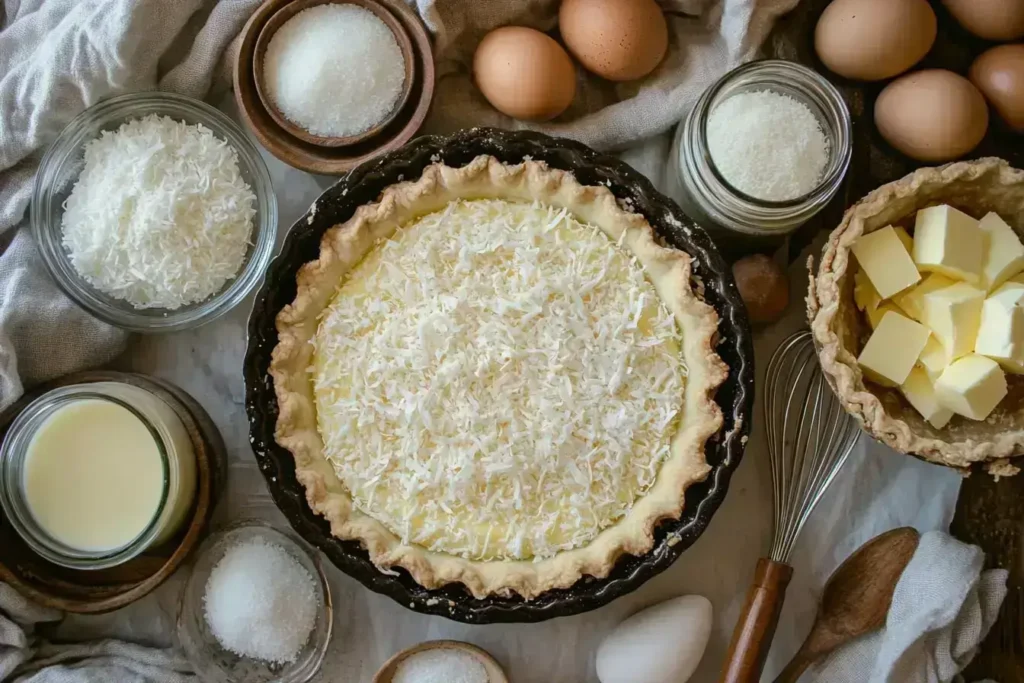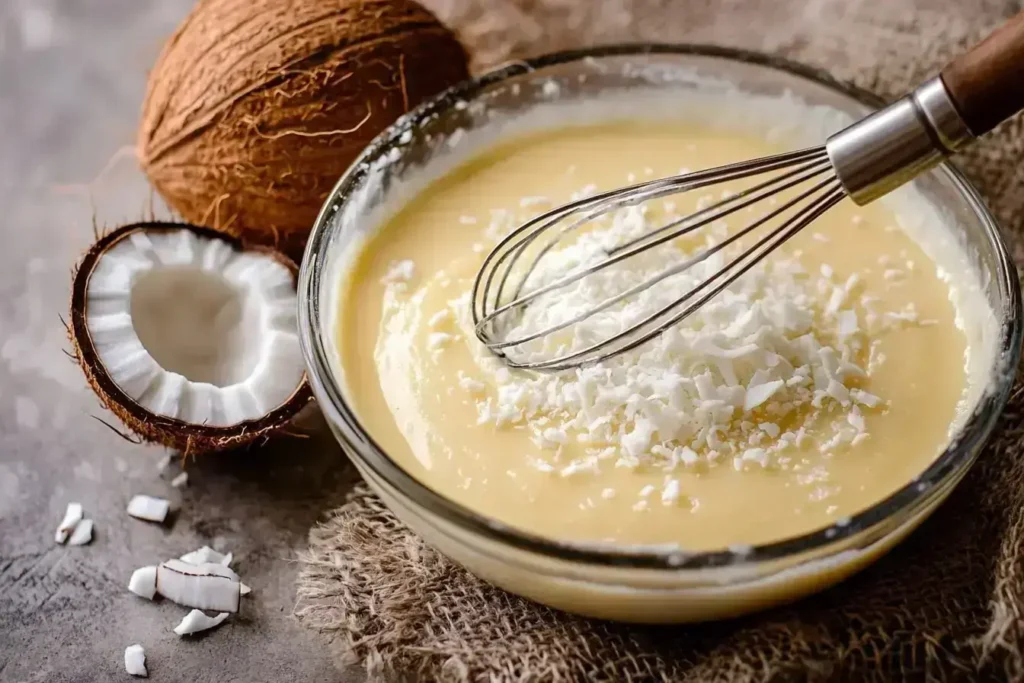There’s something undeniably comforting about a homemade coconut custard pie. Its creamy texture, rich coconut flavor, and flaky crust make it a timeless favorite for dessert lovers. Whether you’re a seasoned baker or a beginner, this guide will help you master the art of making the perfect coconut custard pie. Let’s dive into its history, ingredients, and step-by-step instructions to ensure your pie turns out delightful every time!
What is a Coconut Custard Pie?
Coconut custard pie is the perfect marriage of rich, creamy custard and the tropical essence of coconut, all cradled in a golden, buttery crust. This dessert is beloved for its simplicity and elegance—a combination that makes it both a nostalgic favorite and a modern crowd-pleaser. The custard, made with a blend of eggs, sugar, and coconut milk or cream, bakes to a silky smooth consistency that’s firm enough to hold its shape yet soft enough to practically melt in your mouth.
What truly sets this pie apart is its balance of textures and flavors. The creamy custard provides a luxurious mouthfeel, while the flaky crust offers a satisfying crunch. To top it off, a generous sprinkling of toasted coconut elevates the experience, adding a nutty, caramelized crunch that contrasts beautifully with the smooth filling. Imagine taking a bite—it’s like a warm tropical breeze, wrapped in a dessert.
Coconut custard pie isn’t just delicious; it’s also versatile. It can be enjoyed warm for a comforting treat or chilled for a refreshing dessert on a hot day. Its timeless appeal lies in its ability to cater to diverse tastes, offering a little slice of paradise no matter the occasion. Whether served at a family gathering, a holiday dinner, or a casual weekend treat, this pie has a way of bringing people together over its irresistible flavor and texture.
So, what makes coconut custard pie a standout among desserts? It’s more than the ingredients—it’s the love and care baked into each slice. From the delicate crust to the golden layer of toasted coconut, every component works in harmony to create a dessert that’s as pleasing to the eyes as it is to the palate. This pie isn’t just a dessert; it’s an experience that reminds us of the joys of simple, homemade indulgence.
“Coconut custard pie is like a warm hug from the tropics—a dessert that feels familiar yet exotic.”
Why Coconut Custard Pie is a Timeless Favorite
What makes coconut custard pie a dessert that never goes out of style? Its classic charm lies in its simplicity, versatility, and the nostalgic comfort it brings to those who savor it. Let’s take a closer look at why this pie holds a special place in the hearts of dessert lovers.
A Nostalgic Dessert with Universal Appeal
Coconut custard pie has been a staple in kitchens for generations, often featured in cherished family recipes passed down through the years. Its combination of creamy custard and tropical coconut reminds many of childhood gatherings, family dinners, and special celebrations. The pie’s ability to evoke memories and connect people makes it more than just a dessert—it’s a piece of culinary history that transcends time.
Even for those new to the pie, its universal appeal ensures that everyone can find something to love. Whether it’s the flaky crust, the silky filling, or the crunchy toasted coconut topping, this dessert delivers a little bit of magic in every bite.
A Dessert That Fits Any Occasion
Another reason for coconut custard pie’s lasting popularity is its versatility. It effortlessly fits into a variety of occasions. Need a show-stopping dessert for Thanksgiving? Coconut custard pie can hold its own next to pumpkin or pecan pie. Looking for something light and refreshing for a summer BBQ? Chill it and serve with a dollop of whipped cream for a tropical twist.
This pie also adapts well to personal preferences. You can tweak its sweetness, enhance it with additional flavors like nutmeg or lemon zest, or even turn it into mini pies for individual servings. Its adaptability ensures it remains a go-to dessert, regardless of the season or event.
Ingredients Needed for the Perfect Coconut Custard Pie

Creating the perfect coconut custard pie begins with gathering high-quality ingredients. Here’s a comprehensive breakdown of what you’ll need and why each ingredient matters.
Key Ingredients and Their Roles
- Pie Crust – The base of the pie, providing structure and a buttery flavor. You can use store-bought or make your own.
- Coconut Milk or Cream – For a rich, tropical flavor.
- Shredded Coconut – Adds texture and enhances the coconut profile.
- Eggs – Essential for setting the custard.
- Sugar – Sweetens the custard and balances the coconut’s natural richness.
- Vanilla Extract – Rounds out the flavors with a hint of warmth.
- Butter – Adds creaminess and a velvety texture.
- Salt – Balances the sweetness and enhances flavor.
Choosing the Best Coconut for Your Pie
Should you use fresh or dried coconut? While fresh coconut offers unbeatable flavor, sweetened shredded coconut is more convenient and widely available. It’s all about what works best for your recipe and schedule.
Substitutes for Common Ingredients
Missing an ingredient? No problem. Here are some handy substitutions:
- No coconut milk? Use regular milk with a few drops of coconut extract.
- Out of eggs? Try cornstarch as a thickening agent, though the texture may differ slightly.
- Avoiding sugar? Swap with honey or a sugar substitute.
Step-by-Step Instructions for Making Coconut Custard Pie

Now that you have your ingredients ready, let’s get baking! Follow these steps to create a coconut custard pie that’s as good as (if not better than) your grandma’s recipe.
Preparing the Crust: Store-Bought vs. Homemade
If you’re short on time, a store-bought crust is perfectly fine. But if you want to go the extra mile, here’s a quick recipe for a homemade crust:
Ingredients for Homemade Crust:
- 1 ¼ cups all-purpose flour
- ½ teaspoon salt
- ½ cup unsalted butter, chilled and diced
- 3-4 tablespoons ice water
Instructions:
- Combine flour and salt in a mixing bowl.
- Cut in the butter using a pastry cutter or fork until the mixture resembles coarse crumbs.
- Gradually add ice water, one tablespoon at a time, until the dough comes together.
- Roll out the dough on a floured surface, then transfer it to your pie dish.
Crafting the Creamy Custard Filling
The filling is the star of this pie, so take your time to get it just right.
Ingredients for Custard Filling:
- 3 large eggs
- 1 cup coconut milk
- ½ cup sugar
- 1 cup shredded coconut
- 1 teaspoon vanilla extract
- ¼ teaspoon salt
- 2 tablespoons melted butter
Instructions:
- Preheat your oven to 350°F (175°C).
- In a large bowl, whisk the eggs until smooth.
- Add coconut milk, sugar, shredded coconut, vanilla extract, salt, and melted butter. Mix well.
- Pour the filling into the prepared crust.
Baking Tips for a Perfect Texture
- Place the pie in the center of the oven and bake for 45–50 minutes or until the custard is set but slightly jiggly in the middle.
- To prevent the crust from overbrowning, cover the edges with aluminum foil during the last 15 minutes of baking.
- Allow the pie to cool completely before slicing. This helps the custard set fully and ensures clean slices.
Common Problems and Solutions for Coconut Custard Pie
Even experienced bakers face challenges with custard pies. Here are some common issues and how to fix them.
Why Does the Custard Turn Watery?
This usually happens when the custard is overbaked or the oven temperature is too high. Always bake at a steady temperature and check for doneness with a gentle jiggle test.
Preventing a Burnt Crust While Baking
Burnt crusts can ruin your pie’s presentation. Use a pie shield or aluminum foil to protect the edges, especially if you’re using a dark metal pan that conducts heat quickly.
Achieving the Ideal Balance of Sweetness
Not sweet enough? Add a touch of honey to the custard mixture. Too sweet? Use unsweetened coconut or cut back on sugar slightly.
Table: Ingredients and Nutritional Information
Here’s a quick reference for the ingredients and their nutritional values per serving of coconut custard pie.
| Ingredient | Quantity | Calories |
|---|---|---|
| Pie Crust | 1 (9-inch) | 1200 |
| Coconut Milk | 1 cup | 445 |
| Shredded Coconut | 1 cup | 280 |
| Eggs | 3 large | 210 |
| Sugar | ½ cup | 387 |
| Vanilla Extract | 1 teaspoon | 12 |
| Butter | 2 tablespoons | 204 |
| Salt | ¼ teaspoon | 0 |
Variations on the Traditional Coconut Custard Pie Recipe
Coconut custard pie is a classic, but why not give it your own twist? Whether you’re catering to dietary restrictions or simply craving something new, these variations will keep things exciting while retaining the pie’s comforting essence.
Gluten-Free Coconut Custard Pie
For those avoiding gluten, swapping out the traditional crust is easier than you think. Here’s how to make a delicious gluten-free version without sacrificing flavor.
Gluten-Free Crust Ingredients:
- 1 ½ cups almond flour
- ¼ cup coconut flour
- 2 tablespoons sugar
- ½ cup unsalted butter (cold, diced)
- 1 large egg
Instructions:
- Combine almond flour, coconut flour, and sugar in a bowl.
- Cut in the butter until the mixture resembles breadcrumbs.
- Add the egg and mix until a dough forms. Chill for 20 minutes.
- Roll out the dough between two sheets of parchment paper and transfer to a pie dish.
This crust pairs beautifully with the traditional coconut custard filling while accommodating gluten-free diets.
Vegan Coconut Custard Pie Recipe
Skipping eggs and dairy doesn’t mean skipping flavor. Here’s a plant-based twist on the classic.
Ingredients for Vegan Custard Filling:
- 1 cup coconut cream
- ½ cup almond milk
- ⅓ cup maple syrup
- 2 tablespoons cornstarch
- 1 cup shredded coconut
- 1 teaspoon vanilla extract
Instructions:
- In a saucepan, whisk coconut cream, almond milk, maple syrup, and cornstarch over medium heat until thickened.
- Remove from heat, stir in shredded coconut and vanilla extract, then pour into a prepared vegan pie crust.
- Bake at 350°F (175°C) for 40–45 minutes.
This variation is creamy, flavorful, and perfect for vegans or those with egg allergies.
Adding a Tropical Twist: Pineapple or Mango Enhancements
Want to amp up the tropical vibes? Incorporate diced pineapple or mango into your filling. Simply fold in ½ cup of your chosen fruit before pouring the custard into the crust. The sweetness and tanginess of the fruit complement the creamy custard and add a delightful surprise in every bite.
“Think of these variations as a canvas where you can paint your culinary imagination.”
Serving and Storing Coconut Custard Pie
Once your pie is ready, the next step is serving it like a pro and storing leftovers to keep them fresh. Here’s what you need to know.
The Best Ways to Serve for Maximum Enjoyment
Coconut custard pie is versatile when it comes to serving. Here are some ideas:
- Warm with Ice Cream: A slice served warm with a scoop of vanilla ice cream is pure bliss.
- Chilled with Whipped Cream: Refrigerate the pie for a few hours, then top with freshly whipped cream and toasted coconut for a light, refreshing treat.
- Garnished with Fruit: Add sliced strawberries or kiwis for a pop of color and added sweetness.
Proper Storage Tips to Maintain Freshness
To keep your pie tasting its best:
- Refrigerate: Store the pie in an airtight container or cover it with plastic wrap. It will last up to 3–4 days in the fridge.
- Freeze for Later: Wrap individual slices tightly in plastic wrap and place them in a freezer-safe container. They can be stored for up to a month. Just thaw in the refrigerator before serving.
Health Benefits of Coconut and Custard Ingredients
While coconut custard pie isn’t exactly a health food, some of its ingredients offer nutritional perks worth noting.
Nutritional Benefits of Coconut
Coconut is packed with healthy fats, specifically medium-chain triglycerides (MCTs), which are known for providing a quick energy boost. It’s also rich in fiber, aiding digestion, and contains essential minerals like manganese and copper.
Low-Calorie Tweaks for Health-Conscious Bakers
Want to enjoy coconut custard pie guilt-free? Try these modifications:
- Use Stevia or Monk Fruit Sweetener instead of sugar.
- Swap Heavy Cream with Coconut Milk Light for fewer calories.
- Opt for an Oat-Based Crust to increase fiber content.
Even small changes can make this indulgent dessert a bit healthier without compromising taste.
Frequently Asked Questions About Coconut Custard Pie
How is coconut custard pie different from coconut cream pie?
Coconut custard pie is baked, setting the custard with eggs in the oven, while coconut cream pie features a pre-cooked filling poured into a baked crust and topped with whipped cream.
Can I use sweetened condensed milk instead of sugar?
Yes, sweetened condensed milk can replace sugar, but reduce the coconut milk to balance the consistency.
Why is my pie soggy at the bottom?
A soggy bottom crust is often due to an underbaked crust. Pre-bake the crust (blind baking) before adding the filling to prevent this.
What’s the best type of pie dish to use?
Glass or ceramic pie dishes are ideal as they distribute heat evenly, ensuring the custard sets properly.
How can I toast coconut for garnish?
Spread shredded coconut on a baking sheet and bake at 350°F (175°C) for 5–7 minutes, stirring occasionally, until golden brown.
Is coconut custard pie safe to leave out overnight?
No, since it contains eggs and dairy, it should be refrigerated within two hours to prevent spoilage.
Conclusion: The Perfect Ending with Coconut Custard Pie
Coconut custard pie is more than just a dessert—it’s an experience. From its creamy filling to the flaky crust, every bite feels like a tropical getaway. With the tips, tricks, and variations shared here, you’re equipped to create a pie that’s not only delicious but also uniquely yours. So grab your whisk, preheat that oven, and start baking. The perfect coconut custard pie awaits!

